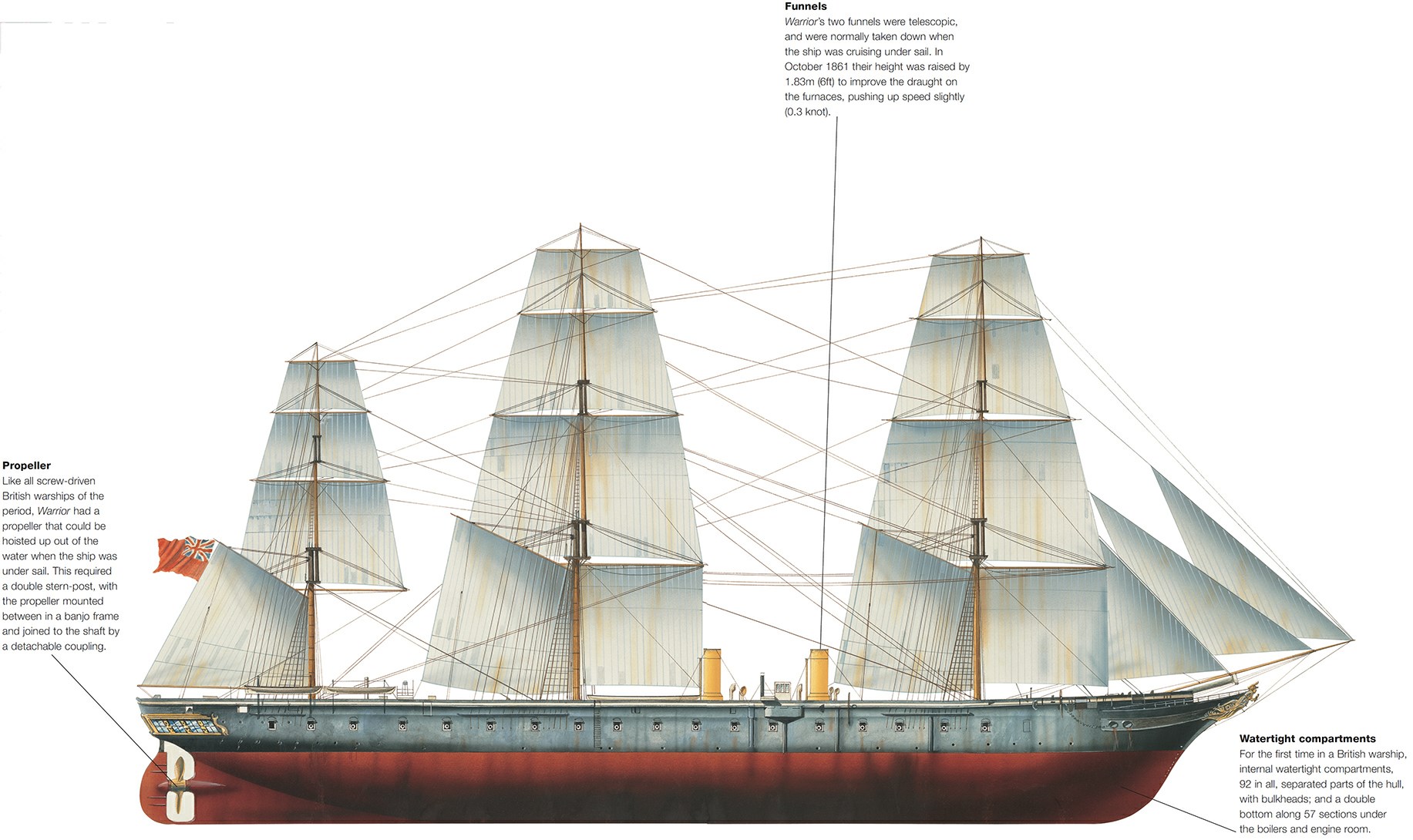
Warrior is a ship of imposing appearance. The hull was painted black, unlike the chequered style of sailing frigates, and seemed immensely long to contemporaries. The great space between foremast and mainmast is very noticeable. When it and the similarly painted Black Prince joined the Channel Fleet they were described as ‘two black snakes among the rabbits’. They were the only British ironclads with wooden lower masts and caps, though at an early design stage four or even five iron masts had been considered. The original bowsprit was 14.9m (49ft) long but because of the ship’s excessive weight in the forward section it was halved in length in March 1862, and the full head-gear was not restored until the poop deck was added between 1872 and 1875, giving the vessel a better balance. Total sail area was 4496.5m2 (48,400sq ft) including stunsails.
The steam ironclad Warrior was planned as a direct response
to France’s Gloire. Laid down at Mare’s yard at Blackwall on the Thames on 25
May 1859, launched on 29 December 1860, commissioned at Portsmouth in August
1861 and finally completed on 24 October that year, it cost £377,292.
Its hull construction marked a clear break with the old
wooden-hulled tradition. It was to carry 40 large guns on a single deck. But
the design showed compromises between the new and the old: Warrior’s heavy
‘knee bow’ design was a convention rather than a structural requirement, and
weighed the vessel down at the bow end until a shelter-deck was erected at the
poop. The wide stern was simply copied from existing sailing frigate models.
Warrior was one of the last three Royal Navy ships to be given a carved
figurehead. Another traditional feature, not necessary on an ironclad, was the
solid timber bulwarks surrounding the upper deck.
The teak-backed armour plating was applied to the midships
section only, 64.9m (213ft) long and 8.23m (27ft) vertically, with 1.83m (6ft)
below the waterline. Two bilge keels were fitted to reduce any propensity to
roll. The Penn horizontal trunk engine was the most powerful yet installed on a
warship.
Third-rate
The new ship presented a problem of classification: its
single gun deck defined it as a frigate but as it was expressly designed to
overtake and defeat any existing warship, that was clearly inappropriate. The
solution was to use its 707-man complement (equivalent to that of a third-rate)
as a reason to classify it and its sister ship Black Prince as third-rates. The
114mm (4.5in) steel plating was impenetrable by any naval gun of the time (but
by 1863 guns had been introduced to pierce such armour). Warrior’s 103.6m
(340ft) length was notable: great length was identified with the ability to go
fast. Sir Baldwin Walker, Controller of the Navy, considered that speed was of
the utmost importance ‘and absolutely essential in seagoing ships cased with
iron’. Care had been taken in designing the underwater lines – even under
canvas alone, Warrior recorded 13 knots under plain sail and stunsails, and
under combined power on 15 November 1861 it made 16.3 knots.
Auxiliary equipment
Warrior was still a broadside ship, its guns arranged in
traditional fashion facing outwards. In 1867 the ship was completely re-gunned,
with 24 178mm (7in) MLR, 4 203mm (8in) MLR, and 4 9kg (20lb) breech loaders.
The Admiralty was slow to take advantage of steam power for auxiliary
equipment. Originally the only extra was a steam pump. The two-bladed, 9 tonne
(10 tons) screw (the largest hoisting screw ever in service) was said to need
600 men to hoist it using the sheerlegs mounted above the double sternposts.
Black Prince received a steam capstan before Warrior, geared to the pump
engine. Prior to that, 90 men were needed to work the main capstan. Steering
gear was done with a fourfold handwheel set abaft the mizzen mast, and directed
from a low bridge mounted on the quarter-deck bulwarks, with an armour-plated
blockhouse structure beneath. But the steamships’ length had an adverse effect
on manoeuvrability. The Navy Controller’s specification required only three
turns of the wheel to give a full degree of helm, as with narrow-ruddered
sailing ships; this made steering of a long screw-driven ship an immensely
heavy task (a fourth turn was conceded in 1861 for steamships of more than
298kW (400hp). Warrior carried two bower and two sheet Admiralty-pattern
wooden-stocked anchors, each weighing 4.3 tonnes (4.75 tons), 1.42 tonne (1.67
tons) iron-stocked stream anchor, and two iron-stocked 0.87 tonnes (0.96 tons)
kedge anchors.
Years of service
In 1904 it was a torpedo school and later an oil hulk before restoration to original condition in the 1980s. It is now a museum ship at Portsmouth. With Black Prince it towed a floating dock across the Atlantic from Madeira to Bermuda in 1869. Another refit between 1872 and 1875 saw it provided with the poop deck and steam capstan, and it served as coastguard ship at Portland, then from 1881 to 1884 as a training ship for reservists on the Clyde. In 1881 it was re-classified as an armoured cruiser. In 1904 it was adapted for service with the HMS Vernon torpedo school and the cut-down hull was finally transferred to Pembroke to provide a pier for an oil pipe-line.
General characteristics
Class and type: Warrior-class
armoured frigate
Displacement: 9,137
long tons (9,284 t)
Length: 420 ft (128.0
m) (o/a)
Beam: 58 ft 4 in
(17.8 m)
Draught: 26
ft 10 in (8.2 m)
Installed power:
5,772 ihp (4,304
kW)
10 rectangular
boilers
Propulsion: 1
shaft, 1 Trunk steam engine
Sail plan: Ship
rig
Speed: 14 knots (26
km/h; 16 mph)
Range: 2,100 nmi
(3,900 km; 2,400 mi) at 11 kn (20 km/h; 13 mph)
Complement: 706
officers and enlisted men
Armament:
26 × Smoothbore
muzzle-loading 68-pounder (206 mm) guns
10 × Rifled
breechloading 110-pounder (178 mm) guns
4 × Rifled
breechloading 40-pounder (121 mm) guns
Armour:
Belt: 4.5 in (114
mm)
Bulkheads: 4.5 in
(114 mm)